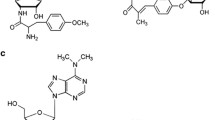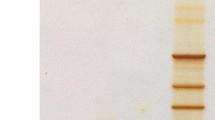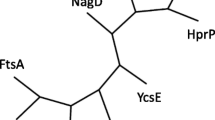Abstract
Orotidine-5′-monophosphate decarboxylase (OMPdecase) catalyzes the final step in pyrimidine biosynthesis, the conversion of orotidine-5′-monophosphate (OMP) to uridine-5′-monophosphate. ThepyrF gene, encoding OMPdecase, was isolated from a chromosomal library ofPseudomonas aeruginosa PAO1 by screening for complementation of anEscherichia coli and aP. aeruginosa pyrF mutant. The nucleotide sequence of a 2510-bp chromosomal DNA fragment, complementing both strains, was determined (EMBL accession number X65613). On this a 696-bp open reading frame capable of encoding the 24 kDa OMPdecase was identified. Despite a generally good correspondence to other OMPdecase sequences, theP. aeruginosa gene was unique in that it did not constitute part of an operon. ThepyrF gene was amplified by polymerase chain reaction, overexpressed in the pT7-7/E. coli BL21(DE3) system and purified to near electrophoretic homogeneity by anion exchange chromatography. Characterization of the purified enzyme revealed the following data, aK m value for OMP of 9.91 μM and an isoelectric point of 6.65. No major decrease in enzyme activity was observed in a pH range between 7.8 and 10.2. Gel electrophoresis under nondenaturing conditions suggested that the native form of OMPdecase is the dimer.
Similar content being viewed by others
Literature Cited
Bagdasarian M, Lurz R, Rueckert B, Franklin FCH, Bagdasarian MM, Frey J, Timmis KN (1981) Specific-purpose plasmid cloning vectors. II. Broad host range, high copy number, RSF 1010-derived vector systems for gene cloning inPseudomonas. Gene 16:237–247
Bradford MM (1976) A rapid and sensitive method for the quantification of microgram quantities of protein utilizing the principle of protein-dye binding. Anal Biochem 72:248–254
Chomczynski P, Sacchi N (1987) Single-step method of RNA isolation by acid guanidinium thiocyanate-phenol-chloroform extraction. Anal Biochem 161:156–159
Corpet F (1988) Multiple sequence alignment with hierarchical clustering. Nucleic Acids Res 16:10881–10890
Davis BD, Mingioli ES (1950) Mutants ofEscherichia coli requiring methionine or vitamin B12. J Bacteriol 60:17–28
Diaz-Minguez JM, Iturriaga EA, Benito EP, Corrochano LM, Eslava AP (1990) Isolation and molecular analysis of the orotidine-5′-phosphate decarboxylase gene (pyrG) ofPhycomyces blakesleeanus. Mol Gen Genet 224:269–278
Donovan WP, Kushner SR (1983) Cloning and physical analysis of thepyrF gene (coding for orotidine-5′-phosphate decarboxylase) fromEscherichia coli K-12. Gene 25:39–48
Isaac JH, Holloway BW (1968) Control of pyrimidine biosynthesis inPseudomonas aeruginosa. J Bacteriol 96:1732–1741
Kho CJ, Zarbi H (1992) A rapid and efficient protocol for sequencing plasmid DNA. BioTech 12:228–229
Kimsey HH, Kaiser D (1992) The orotidine-5′-monophosphate decarboxylase gene ofMyxococcus xanthus. J Biol Chem 267:819–824
Laemmli UK (1970) Cleavage of structural proteins during the assembly of the head of bacteriophage T4. Nature 227:680–685
Liebermann I, Kornberg A, Simms ES (1955) Enzymatic synthesis of pyrimidine nucleotides orotidine-5′-phosphate and uridine-5′-phosphate. J Biol Chem 215:403–415
Olsen RH, DeBusscher G, McCombie WR (1982) Development of broad-host-range vectors and gene banks: self-cloning of thePseudomonas aeruginosa chromosome. J Bacteriol 150: 60–69
Palleroni NJ (1984) Gram-negative aerobic rods and cocci. In: Krieg NR, Holt JG (eds) Bergey's manual of systematic bacteriology. Baltimore: Williams and Wilkins, p 165
Quinn CL, Stephenson BT, Switzer RL (1991) Functional organization and nucleotide sequence of theBacillus subtilis pyrimidine biosynthetic operon. J Biol Chem 266:9113–9127
Radford A (1993) A fungal phylogeny based upon orotidine-5′-monophosphate decarboxylase. J Mol Evol 36:389–395
Rose M, Grisafi P, Botstein D (1984) Structure and function of the yeastura3 gene: expression inEscherichia coli. Gene 29:113–124
Royle PL, Matsumoto H, Holloway BW (1981) Genetic circularity of thePseudomonas aeruginosa PAO chromosome. J Bacteriol 145:145–155
Sambrook J, Fritsch EF, Maniatis T (1989) Molecular cloning. A laboratory manual, 2nd ed. Cold Spring Harbor, NY: Cold Spring Harbor Laboratory Press.
Sanger F, Nicklen S, Coulson AR (1977) DNA sequencing with chain-terminating inhibitors. Proc Natl Acad Sci USA 74:5463–5467
Savioz A, Zimmermann A, Haas D (1993)Pseudomonas aeruginosa promoters which contain a conserved GG-N10-GC motif but appear to be RpoN-independent. Mol Gen Genet 238:74–80
Smiley JA, Jones ME (1992) A unique catalytic and inhibitor-binding role for Lys93 of yeast orotidylate decarboxylase. Biochem 31:12162–12168
Studier FW, Rosenberg AH, Dunn JJ, Dudendorff JW (1990) Use of T7 RNA polymerase to direct expression of cloned genes. Methods Enzymol 185:60–89
Suttle DP, Bugg BY, Winkler JK, Kanalas JJ (1988) Molecular cloning and nucleotide sequence for the complete coding region of human UMP synthase. Proc Natl Acad Sci USA 85:1754–1758
Tabor S (1990) Expression using the T7 RNA polymerase/promoter system. In: Ausubel FA, Brent R, Kingston RE, Moore DD, Seidman JG, Smith JA, Struhl K (eds) Current protocols in molecular biology. New York: Greene Publishing and Wiley-Interscience, pp 16.2.1–16.2.11
Theisen M, Neuhard J (1990) Translational coupling in thepyrF operon ofSalmonella typhimurium. Mol Gen Genet 222:345–352
Theisen M, Kelln RA, Neuhard J (1987) Cloning and characterization of thepyrF operon ofSalmonella typhimurium. Eur J Biochem 164:613–619
Turnbough CL Jr, Kerr KH, Funderburg WR, Donahue JP, Powell FE (1987) Nucleotide sequence and characterization of thepyrF operon ofEscherichia coli K12. J Biol Chem 262:10239–10245
West SEH, Iglewski BH (1988) Codon usage inPseudomonas aeruginosa. Nucleic Acids Res 16:9323–9335
Yanisch-Perron C, Vieira J, Messing J (1985) Improved M13 phase cloning vectors and host strains: nucleotide sequences of the M13mp18 and pUC19 vectors. Gene 33:103–119
Author information
Authors and Affiliations
Rights and permissions
About this article
Cite this article
Strych, U., Wohlfarth, S. & Winkler, U.K. Orotidine-5′-monophosphate decarboxylase fromPseudomonas aeruginosa PAO1: Cloning, overexpression, and enzyme characterization. Current Microbiology 29, 353–359 (1994). https://doi.org/10.1007/BF01570229
Issue Date:
DOI: https://doi.org/10.1007/BF01570229




